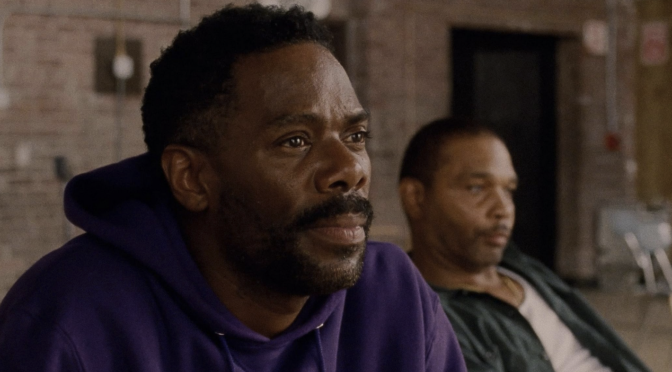One of the best scenes in Greg Kwedar’s SING SING is a simple one: the inmates of a maximum security prison for men gather in a circle to discuss their perfect moment. The exercise is an acting technique to help them become emotionally in tune with their roles. Yet, it also teaches these men how to be vulnerable. Empathy and sincerity brim in this moment and throughout this soulful, lionhearted feature.
The film dramatises a non-profit programme that genuinely occurred at the Sing Sing Correctional Facility – Rehabilitation Through the Arts (RTA) – which used theatre as rehab. John “Divine G” Whitfield (Colman Domingo), incarcerated for a crime he didn’t commit, has found purpose through this programme, using it to help other inmates get in touch with their artistic sides and thus find healthier ways to channel their emotions. Meanwhile, he finds himself anxious at the prospect of an upcoming parole hearing that may determine his freedom.
Domingo is remarkable in this role as a man who does not practice what he preaches. A keen writer with a soft-spoken demeanour, Divine G is a gentle giant who takes care of the wellbeing of his fellow inmates while bottling up his own growing feelings of despair. Domingo is effortless in his display of charming encouragement and blunt observations, all while showcasing subtle but powerful inner turmoil as Divine G’s mask slips gradually. The latter comes to the forefront with the arrival of the combative Clarence “Divine Eye” Maclin (himself), who suggests that the group perform a comedy instead of the usual drama. As Divine Eye’s gruff, cynical beliefs clash with Divine G’s more amiable persona, Domingo’s quiet expressions and subtle gestures hint at the sorrow and frustration bubbling beneath the surface, culminating in a heartbreaking outburst during rehearsals in the final act.
“There is a blistering authenticity to the storytelling that resonates from the screen.”
What makes SING SING such a poignant gem – like other prison dramas such as THE SHAWSHANK REDEMPTION – is that it recognises and champions the humanity of the inmates it’s portraying. Divine G may be innocent, but many around him are men who made mistakes and want to improve. The programme gives these men a means to embrace their creative sides and express a more widespread spectrum of emotions, something that every man in the programme must learn to do. This programme and, by extension, the film advocates for compassionate rehabilitation, arguing that giving people a chance to healthily explore their feelings and nurture artistic abilities as a form of escapism is the greatest form of therapy. A powerful extension of this sentiment is evident in the fact that many of the inmates, including Divine Eye, are previously incarcerated men who took part in this very programme, playing versions of themselves in this film.
Kwedar and team bring these values to life through delicate, meticulous craft, shooting on 16mm with an aspect ratio of 1.66:1. The resultant cinematography evokes a sense of intimacy one may experience when reflecting on a memory, the unusually tall shot compositions at times creating the impression of a portrait. The colour palette seems somewhat muted when inside the Sing Sing prison, the dark greens of the prison uniforms evoking as much despondency as the brutalist greys and whites of the prison walls. Yet, on the stage where the inmates perform their bizarre comedic routines – Hamlet and Freddy Krueger are roles in this play – the film comes alive with colour, dazzling with flashy blues and vibrant reds and purples. When the characters meet to develop the play they’re working on, the techniques they practice and the stories they share are entirely improvised – drawn from the cast’s real experiences with the programme. There is a blistering authenticity to the storytelling that resonates from the screen.
“If art can be considered a reflection of the artist’s beliefs and values, then the cast and crew of SING SING have wonderfully presented the importance of sincerity and vulnerability in a world that increasingly seems to resent both.”
At times, the script succumbs to on-the-nose dialogue or plot points that, while perhaps based on the truth, come off as cliche, such as the sudden death of a beloved inmate. However, none of that undermines the candour and lack of cynicism that makes SING SING so heartfelt. In fact, the film’s humour, heart and honesty are all generated by how these characters interact. Kwedar and his team know precisely when to utilise close-ups or give their cast space to achieve maximum emotional effect. Divine G and Divine Eye are radically different types, yet they struggle with the same flaw of resisting vulnerability. This parallel makes their scenes together all the more fascinating and sonorous, with Maclin’s gruff but layered performance rivalling Domingo’s willingness to deconstruct the tough guy act that too many men feel they must adopt.
SING SING is not just a beautifully made, powerfully acted prison drama – it’s living proof of what can be achieved when we nurture compassion and creativity. If art can be considered a reflection of the artist’s beliefs and values, then the cast and crew of SING SING have wonderfully presented the importance of sincerity and vulnerability in a world that increasingly seems to resent both.

